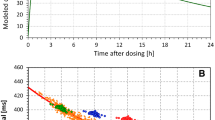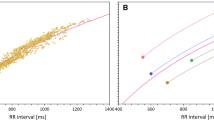Abstract
The QT interval is correlated with heart rate; therefore, the QT interval is usually corrected by heart rate when drug-induced QT effect is studied. Currently, there are many correction methods that use either fixed or data-driven approaches. The effectiveness of correction methods depends on many factors and varies from study to study. Statistical validation and comparisons need to be performed to determine the most appropriate correction method for each study. We examined different validation methods and explored a new approach to use when the testing drug changes heart rate.
Similar content being viewed by others
References
International Conference on Harmonisation. Guidance on E14 clinical evaluation of QT/QTc interval prolongation and proarrhythmic potential for non-antiarrhythmic drugs: availability. Notice. Fed Regist. 2005;70:61134–61135.
Badilini F, Maison-Blanche P, Childers R, et al. QT interval analysis on ambulatory electrocardiogram recordings: a selective beat averaging approach. Med Biol Eng Comput. 1999;37:71–79.
Fossa AA, Wisialowski T, Magnano A, et al. Dynamic beat-to-beat modeling of the QT-RR interval relationship: analysis of QT prolongation during alterations of autonomic state versus human ether a-go-go-related gene inhibition. J Pharmacol Exp Ther. 2005;312:1–11.
Fossa AA, Zhou M. Assessing QT prolongation and electrocardiography restitution using a beat-to-beat method. Cardiol J. 2010;17(3):230–243.
Hosmane B, Locke C, Morris D. QT interval: correction for heart rate. J Appl Res. 2006;6:288–299.
Malik M. Problems of heart rate correction in the assessment of drug-induced QT interval prolongation. J Cardiovasc Electrophysiol. 2001;12:411–420.
Malik M, Färbom P, Batchvarov V, Hnatkova K, Camm AJ. Relation between QT and RR intervals is highly individual among healthy subjects: implications for heart rate correction of the QT interval. Heart. 2002;87:220–228.
Malik M, Hnatkova K, Batchvarov V. Differences between study-specific and subject-specific heart rate corrections of the QT interval in investigations of drug induced QTc prolongation. Pacing Clin Electrophysiol. 2004;27 (6/1):791–800.
Batchvarov V, Malik M, Färbom P. Individual patterns of QT/RR relationship. Cardiac Electrophysiol Rev. 2002;6:282–288.
Ring A. Statistical models for heart rate correction of the QT interval. Stat Med. 2009;29:786–796.
Dmitrienko A, Smith B. Repeated-measures models in the analysis of QT interval. Pharm Stat. 2003;2(3):175–190.
Garnett CE, Beasley N, Atul Bhattaram V, et al. Concentration–QT relationships play a key role in the evaluation of proarrhythmic risk during regulatory review. J Clin Pharmacol. 2008;48(1):13–18.
Author information
Authors and Affiliations
Corresponding author
Additional information
This article reflects the views of the authors and should not be construed to represent FDA’s views or policies.
Rights and permissions
About this article
Cite this article
Dang, Q., Zhang, J. Validation of QT Interval Correction Methods When a Drug Changes Heart Rate. Ther Innov Regul Sci 47, 256–260 (2013). https://doi.org/10.1177/2168479012467018
Received:
Accepted:
Published:
Issue Date:
DOI: https://doi.org/10.1177/2168479012467018




